#homebrew rpg
Text
It has been a while since i posted any drawing, Sooo here's a drawing i made yesterday of my OC
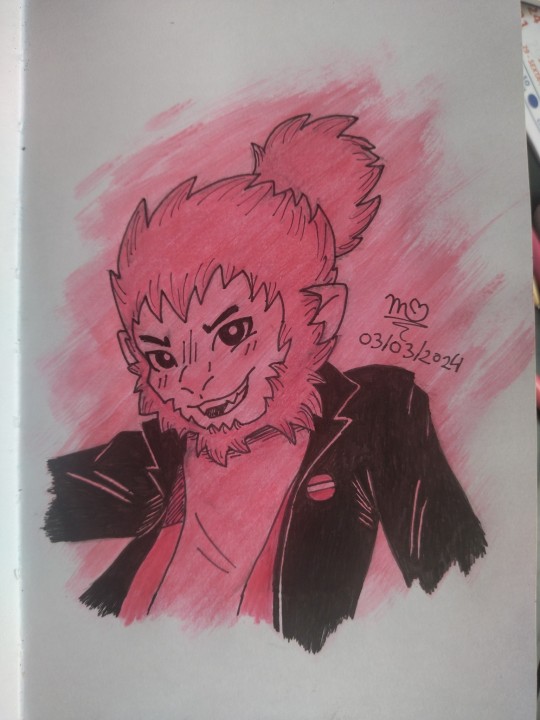
He used to be an rpg character that had a cool backstory for that universe (that unfortunately only had two sessions cause the dm didn't feel like It anymore) but now im not sure if his backstory should still be the same 🤔
(im gonna infodump about him)
He's very Sun Wukong inspired lol and the way i like to describe him is "He's kinda like Sun Wukong, but without powers and a loser".
Well, he WAS going to have some sort of power. Originally the campain was going to be from Ordem Paranormal, a game that has rituals and a bunch of paranormal stuff (it's in the name), very spooky, but then the dm changed it to D&D so i had to take away the cool power he was gonna have T3T.
He would have the rage/hate ritual engraved on his arm, that is basically the rage thing that barbarians have. And since in OP he would be considered a paranormal entity, he would have the urge to eat human flesh, and at the start off every battle, id have to roll to see If i could control the urge to bite whoever was closest to me (and i also had the option to bite myself) so It would be even more interesting to his character, since his whole thing is "i don't want to be the monster people think i am", constantly having to battle against his instincts and stuff.
But then the dm changed it to D&D, which is still cool, but then i had to take away some of the angst cause It didn't fit the game anymore :')
Anyways, If anyone wants to know the backstory from the campain I'll make a post about It ✌️
#artists on tumblr#art#drawing#hand drawn#lmk wukong#sun wukong#ordem paranormal#d&d#dnd character#oc#oc infodump#ramblings#lego monkie kid#homebrew rpg#rpg#ink drawing#painting
10 notes
·
View notes
Text
Six Shooter Universal RPG System
I've been thinking a bit recently, and it feels like the right time to dig my old prototype rules-light game out of its box and release it on the world. If anybody's interested, please feel free to take it for a spin, I'd love to know what you and your friends think of it.
I've also got a separate blog set up where I'll post any new/revised versions, should I continue development on it.
The Basics:
Playing Equipment:
A 52 card deck, jokers optional
A six-sided die (backup dice in case it is lost are also a good idea)
Paper for each player
Pencils for each player
Operators:
Player characters are “Operators,” adventurers, explorers, criminals, mercenaries, and other people who live on the edge. Each Operator starts with a Descriptor, an Archetype, and a Lucky Number.
There are four Descriptors to choose from, each of which correlates to both a specific card suit and a way of solving problems, and which helps give an idea of what an Operator is best at. What Descriptor your Operator has influences how you can use cards (see below, under Playing the Game). The Descriptors are as follows:
Dangerous (Clubs) – Weathering extreme environments, fighting with fists, weapons, or powers, moving heavy objects, and resisting damage. The best fighters are Dangerous.
Sharp (Diamonds) – Solving riddles and academic problems, carefully observing the world around you, having just the right bit of knowledge, or breaking through digital security systems. The best thinkers are Sharp.
Sly (Spades) – Going unnoticed, disguising yourself, unlocking physical security systems, and picking pockets. The best sneaks are Sly.
Charming (Hearts) – Persuading, deceiving, intimidating, negotiating, and networking. The best talkers are Charming.
An Operator’s Archetype has no direct bearing on game mechanics, but it is very important for helping make sense of how that Operator interacts with the world around them. An Archetype is a word or short phrase that you use to get across the most important parts of who your character is, what they can do, and how they fit into the world around them. For example, a medieval Knight and a wild-west Gunslinger will probably both be Dangerous and specialize in fighting, but the actions their rolls represent will probably be very different. Likewise, even within the same game, a medieval Knight and a medieval Famed Archer will approach the same situation in different ways and make the same rolls with different descriptions of their actions.
Your Operator’s Archetype should slot in nicely with the genre and tone of the game you’re playing. If you and your friends are playing a standard heroic fantasy game, you probably shouldn’t pick Noir Detective as your Archetype. In a gothic horror game, a Superhero will be similarly out of place.
Each player should pick a Lucky Number for their Operator from 2 to 10. No two Operators at the same table should start with the same Lucky Number.
Setting up the game:
Working clockwise around the table, have each player introduce their Operator, including their Descriptor, Archetype, Lucky Number, and whatever other information they’d like to share.
Shuffle the deck of cards. Clockwise around the table, have the Game Master (GM) deal six cards to each player, then place the rest of the deck in the middle of the table. Each player should place their six cards face-down in a line going from left to right in front of them. This line of cards is the player’s hand. Each card in the player’s hand represents a number from 1 to 6, with 1 being the leftmost card, and each subsequent card’s value increasing by 1, with 6 being the rightmost card.
Have each player turn one card of their choice from their hand face-up and begin the game.
Playing the game:
Deciding Turn Order:
Whenever multiple players want to tackle the same challenge, have them draw from the center deck and immediately discard the cards they drew. The higher the value of the card a player draws, the higher they are in turn order. If two or more players tie, have them draw again, with the one with the higher card going before the other in the turn order.
It’s recommended that the GM keep a piece of scratch paper around to keep track of the current turn order.
If, at any point during the game, the deck runs out of cards, shuffle the discard pile and use it as the deck.
Overcoming Challenges:
Throughout the course of play, the characters will have to roll to try to complete certain objectives. However, the primary purpose of Six Shooter games is for a group of people to improvise and tell a story together, so the GM should only ask for rolls and introduce that degree of randomness in certain situations; when there is a real possibility for characters to fail or have their fortunes change. Rolls are made with a six-sided die, and the outcome of the die roll is measured against something called the Critical Number.
The Critical Number represents the difficulty of the task the character is attempting, and has different effects on the game based on whether the outcome of a character’s die roll is lower than, greater than, or equal to the Critical Number.
If the result of the roll is greater than the Critical Number, the Operator overcomes the challenge they are facing.
If the result of the roll is equal to the Critical Number, the Operator overcomes the challenge, but the player must Roll Their Hand (see below).
If the result of the roll is less than the Critical Number, the Operator does not overcome the challenge (and may have to deal with the in-story consequences of failure), and the player must Roll Their Hand.
A challenge’s Critical Number gives a rough idea of how difficult the challenge in question should be for the Operators. You don’t have to tell your players the exact Critical Numbers for challenges before they roll, but it’s generally polite to give them a rough idea of how difficult a certain challenge will be (or at least, how difficult it might seem to their Operators). Here’s some guidelines to give the GM a rough idea of how to assign Critical Numbers for challenges:
0 or lower – The Operator overcomes the challenge without having to roll. Challenges should not naturally have this Critical Number, but it can happen if the player uses a card (see below) to reduce the Critical Number of a challenge.
1 – The Operator is sure to succeed, but it might take a little effort and luck on their part to do so.
2 – There is a slight chance for the Operator to fail, but they’re still almost certain to succeed. This is a good ‘standard’ Critical Number for challenges, enemies, and obstacles that should wear Operators down but that they should be able to overcome just fine.
3 – The Operator will most likely succeed, but the chance of them failing is not insignificant.
4 – The Operator is as likely to fail as they are to succeed.
5 – There’s a slight chance for the Operator to succeed, but they’re far more likely to fail without rigging the odds in their favor.
6 – The Operator is almost certain to fail, and even succeeding will bring them a little closer to the day their luck runs out.
7 – The Operator will fail unless they use a card or the All Or Nothing rules (see below), and even then, their success is likely still far from assured. Multiple Strikes (see below) will never increase a Critical Number above 7.
Impossible – There’s no point in the character rolling because what they’re trying is completely impossible within the bounds of the story you are telling, so they don’t roll and need to search for a different solution to the problem. For example, unless your game is set in a fairy tale world where people can climb moonbeams, a character attempting to climb moonbeams would result in this.
A single challenge might have multiple Critical Numbers, one each for trying to overcome a challenge through Danger, Sharpness, Slyness, or Charm. For example, a locked door challenge might have a Critical Number of 4 if an Operator uses Slyness to pick the lock, 5 if they try to break the door down, 7 to try to find some hidden weakness in the door with Sharpness, and be Impossible to overcome with Charm (of course, if there’s a guard with keys on the other side of the door, then that’s a different challenge altogether).
A character failing to overcome a challenge does not necessarily mean that they can’t try again. If there’s no time limit or imminent danger, then the only immediate consequence of failure might be the player having to Roll Their Hand. Of course, after a certain number of failures, the GM might decide to move the story along without the Operator having succeeded, with any consequences that follow being yet more challenges for the Operators to deal with.
Rolling Your Hand:
As mentioned above, when the result of your roll is equal to or less than a challenge’s Critical Number, you must Roll Your Hand. What this means is that you roll the die another time, then find the card in your hand that matches the number you rolled. What happens next depends on whether that card is face-down, face-up, or has already been discarded.
If the card is face-down, flip it face-up.
If the card is face-up, discard it without gaining any benefits.
If the card has already been discarded and is missing, you gain a Strike.
Strikes:
Strikes are used to abstractly represent your Operator’s luck slowly but surely running out, as well as accumulating disadvantages like serious injuries or running lower on resources. For each Strike you have, the Critical Number of all challenges is increased by 1 (but never above 7) for your Operator and your Operator only. Once you get your third Strike, your Operator’s luck runs out completely and they are removed from play. This could be used to represent authorities catching them and taking them into custody, old enemies catching up to them, being too injured to continue with the adventure, or even dying.
Using Cards:
Throughout the game, you can use face-up cards from your hand to increase your Operator’s odds of success. You must declare your use of a card and discard it before you make a roll. The Critical Number for your roll is then reduced by a certain value based on the card you used:
2-10 – The Critical Number is reduced by 1.
Jack – The Critical Number is reduced by 2.
Queen – The Critical Number is reduced by 3.
King – The Critical Number is reduced by 4.
Ace – The Critical Number is reduced by 5.
Normally, you can only use a card if its suit matches up with the method you are using to try to overcome a challenge (clubs for Danger, diamonds for Sharpness, spades for Slyness, and hearts for Charm). The one exception is when the method you are using matches your Operator’s Descriptor, in which case you can use a card of any suit to reduce the Critical Number. For example, a Dangerous Operator has no clubs with which to improve his odds when trying to overcome a challenge in a Dangerous way, but he does have a face-up three of spades, which he uses instead.
You can also use a card to improve another Operator’s odds, but only if the suit of the card you are using, your Operator’s Descriptor, and the method they are using all match up. For example, if a Charming Operator is trying to sneak unnoticed past a guard with Slyness, the player of a Sly Operator can use her face-up jack of spades to reduce the Critical Number of the challenge by 2 for the Charming Operator. As above, the card must be used before the roll takes place.
Only 1 card can be used on any given roll.
Beyond the raw mechanical benefits, the use of cards is an excellent time for players to have an influence on the flow of the plot and let their Descriptor and Archetype shine. The reduction of the Critical Number of a challenge might be the result of an Operator using a special hidden ability or piece of technology, or a non-player-character ally showing up in the nick of time to help out. Essentially, the GM should let payers suggest plot twists or give their character a shining moment whenever they use a card, with face cards and Aces allowing for bigger twists and brighter moments.
All Or Nothing:
Certain high-tension situations, where an Operator takes a huge risk or puts everything on the line (a showdown at high noon is a good example) fall into All Or Nothing territory. If an Operator takes an All Or Nothing approach to overcome a challenge, they can wager any number of Strikes (though the Strikes wagered and the Strikes a player already has can total no more than 3) before making their roll. For each Strike wagered, the Critical Number of the roll is reduced by 1. If the Operator overcomes the challenge, the wagered Strikes do not take effect. If the Operator fails, then that player immediately gains a number of Strikes equal to the ones wagered, possibly enough to remove their Operator from the game.
Cards cannot be used on the same roll as All Or Nothing.
Both the GM and the players should be judicious about the use of All Or Nothing moments. This mechanic is especially designed to represent climactic scenes.
Lucky Numbers:
An Operator’s Lucky Number comes into play whenever their player discards a card with the matching value, whether it was the result of Rolling Their Hand or using that card. As soon as the card is discarded, the player can replace it by drawing a new card from the central deck and placing it face-up in their hand in the place of the old card.
Combat:
Combat can be modeled two ways. The first is to treat each enemy as its own challenge, and the second is to treat a large group of weak enemies as a single challenge with a higher Critical Number. Both are valid options, and the GM should use whichever one serves a better role in the story at them current moment. Almost all combat is solved with Danger, though the GM can choose to reward creative players if they come up with a reasonable way to solve a combat encounter with a different method.
In Six Shooter games, the accumulation of damage and running out of an Operator’s luck go hand and hand, so there’s no damage mechanic; instead, damage is folded into Rolling Your Hand and Strikes. If a GM wants to introduce more immediate effects of damage, such as a character being momentarily knocked out, they can simply make that the cost of failing to overcome the challenge a certain number of times.
Multi-stage Challenges:
Some obstacles are too big to overcome with a single roll. For example, it would feel rather anti-climactic if the dragon that the Operatives have been tracking for the entire adventure goes down in the first turn of combat because the Dangerous Knight had a really lucky roll.
To represent these advanced enemies, security systems, and other obstacles, use multi-stage challenges. In these cases, the Operatives must collectively succeed on a certain number of rolls before the challenge is overcome. Keep in mind that this exponentially increases the difficulty of challenges with high Critical Numbers.
Player Versus Player Rules:
Since the characters are all on the same team in most games, inner-group conflict should hopefully be rare and able to be solved through communication. Still, some groups may want to have contests between Operators at certain points in the game. To do so, use this rule:
The players of both Operators roll the die once. The player with the lower roll must then Roll Their Hand. If the rolls are equal, then both players must Roll Their Hand. Continue as necessary until one player either concedes defeat or gains a Strike, at which point their Operator loses the contest.
Strikes, using cards, and All Or Nothing all affect the outcome of your opponent player’s die roll the same way they would the Critical Number of a challenge.
Character Progression:
Six Shooter is a good system for pick-up games, but if the GM and players want to create a series of adventures for their characters, they can easily do so with these rules.
At the end of an adventure, if a player has at least one unused face card or Ace face-up in their hand, they can give one Operator at the table (including their own) an extra Lucky Number, chosen by that Operator’s player.
An Operator can have up to two Lucky Numbers at any given time with no restrictions. Past that point, an Operator cannot gain more Lucky Numbers unless all other Operators have at least as many Lucky Numbers as they do (all Operators must have at least two Lucky Numbers for an Operator to upgrade from two to three, all must have at least three for an Operator to upgrade from three to four, etc.) This is to help prevent large power disparities within a group. Lucky Numbers must be from two to ten, and an Operator cannot have more than one of the same Lucky Number, so by default the absolute cap for lucky numbers is nine. If the GM wishes, they may set the cap lower to better fit the game.
If a player gains three Strikes over the course of an adventure, their Operator is still removed from the current adventure, but can choose to lose a Lucky Number rather than being retired permanently, letting them rejoin the group at the start of the next adventure. Maybe their buddies bailed them out of jail, or their injuries were serious but not lethal. All Strikes are reset at the start of each adventure. If a character has three Strikes and no Lucky Number, they are still retired permanently.
Playing With Jokers:
As mentioned at the start of the manual, jokers can optionally be included in the card deck. In this case, they use the following rules:
A joker can never be discarded from your hand. You cannot use it, and if you would normally lose it through Rolling Your Hand, you instead hang onto it.
A joker has a value of 0 for determining turn order.
39 notes
·
View notes
Text


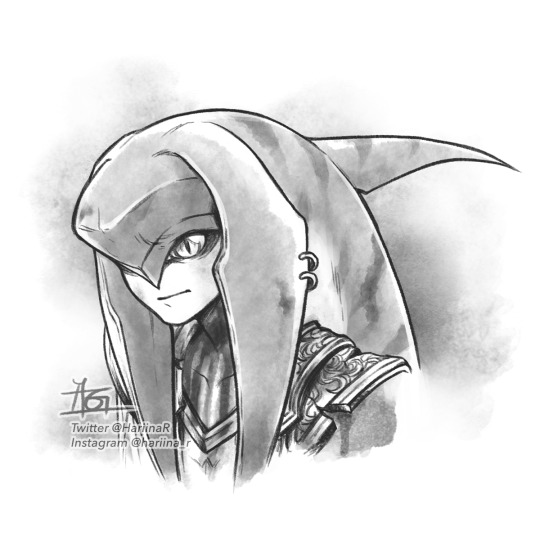
Meeting with Demise.
A bit of Hanon's story below for those interested, also available here in little comic snippets (which might make their way here, I remember really enjoying reading comics on Tumblr :'))!
Hanon spent most of her life trusting she knew where the line between good and evil was. After joining her group - now some of her best friends - in their mission and succeeding in delaying the enemy's progress, they were assigned a new task in the Dark Realm in order to aid Hyrule's army in the war against Vaati and Demise.
Their mission was to destroy a number of crystals in numerous temples in the Dark Realm that, as far as they knew, were protecting the dark god Demise from the Hero of Time. As they progressed, however, something started to bother Hanon - from the state of the Dark Realm, to Vaati appearing in front of them asking them not to set Demise free and strange comments about the god's mercy, the pressure from the increasingly tougher battles they fought finally got to her.
After seeing her friends Neph and Ruby die and experience death herself, Hanon decided to have a word with Demise after they were brought back to life thanks to a handful of fairy magic they held. And what she found was not an evil god set on destruction, but an incarnation of power that wanted to restore his realm to its ancient glory and would grant her the strength she needed to go on protecting those she loved. Without losing the good in her and becoming a beacon of light in a dark world, she accepted to do his bidding.
#hanon akulai#hanon#demise#zelda#the legend of zelda#zelda oc#zora#zora oc#homebrew rpg#ttrpg#fantasy#fantasy art#my art#my characters
37 notes
·
View notes
Text

Rudolf Volt
0 notes
Text



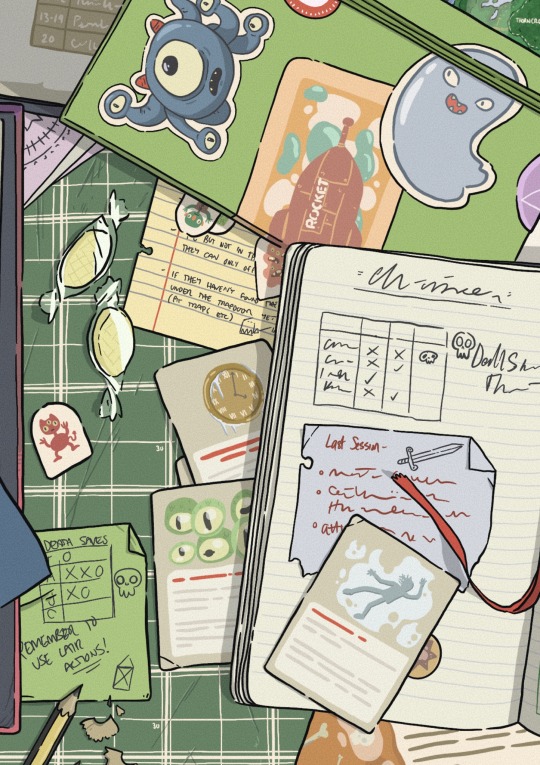
Finished! I think.
A book, scribble and dice based D&D session.
I’ll be exploring the possibility of getting some notebooks printed with this as a wraparound cover, but in the meantime it’s just a fun drawing!
Shop / Instagram
#my art#artists on tumblr#books#illustration#fantasy books#dungeon master#rpg#rpg dice#d&d 5th edition#dnd 5e art#dnd 5e homebrew
6K notes
·
View notes
Text
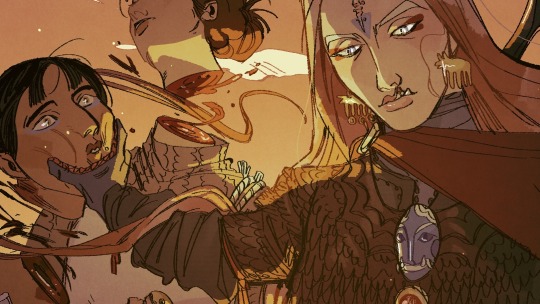



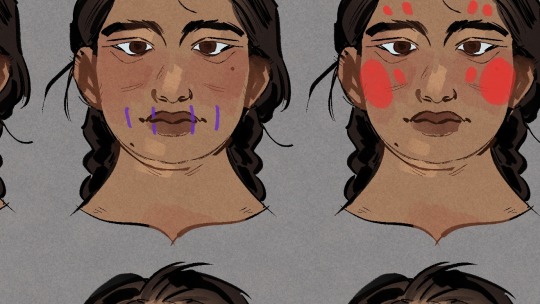
My ttrpg mini book Frumunder will contain old and new art, a homebrew pantheon, premade npcs, and world information available for personal/non commercial use in your own campaigns!
#art#my art#digital art#character design#ocs#original characters#ttrpg#rpg#dnd#dungeons and dragons#frumunder#homebrew#cw blood
1K notes
·
View notes
Text
Help Save the World of TTRPGs and Their Creators.
Okay I’m being a little dramatic, but at the same time I’m pretty serious. This is a call to action, and the livelihoods of myself and lots of other people, many of them (like myself) disabled, are depending on it. This is a post about why, what you can do about it, and (perhaps least often answered) how.
This post is actually an accompaniment to another discussion by someone else. If you don’t want to listen to a 90-minute in-depth discussion of much of what I’m about to tell you, you can just keep reading. Otherwise, click here or here and listen to this either before or after you read this post. (They’re the same thing, just different sources.)
If you have ever made or reblogged posts urging people to switch from Google Chrome to Firefox, you should be willing to at least give a try to other TTRPGs besides D&D5e for much the same principle reasons. I’m not telling you you have to hate D&D5e, and I’m not telling you you have to quit D&D5e, I’m just asking you to try some other games. If you don’t like them, and you really want to go back to D&D5e, then go back to D&D5e. But how can you really know you won’t like other games if you have literally never tried them? This post is a post about why and how to try them. If you’re thinking right now that you don’t want to try them, I urge you to look below to see if any of your reasons for not wanting to try them are covered there. Because the monopoly that WotC’s D&D5e has on TTRPGs as a whole is bad for me as a game designer, and it’s bad for you as a game player. It’s even bad for you if you like D&D5e. A fuller discussion of the why and how this is the case can be found in the links above, but it isn’t fully necessary for understanding this post, it’ll just give you a better perspective on it.
If you’re a D&D5e player, I’m sure at some point or another, you’ve been told “play a different game”, and it must get frustrating without the context of why and how. This post is here to give you the why and how.
[The following paragraph has been edited because the original wording made it sound like we think all weird TTRPGs suck.]
Before that though, one more thing to get out of the way. I'm going to level with you. There’s a lot of weird games out there.
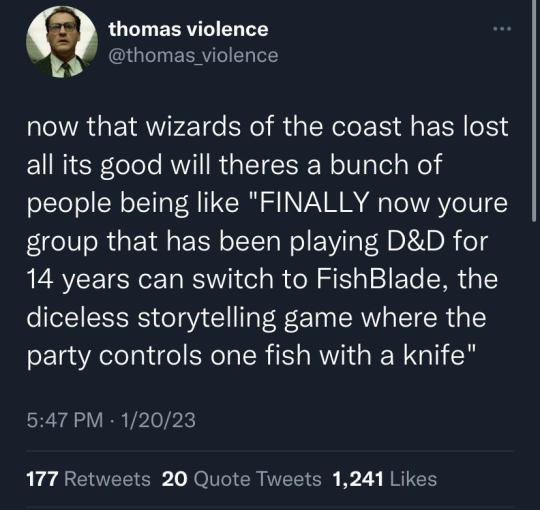
You are gonna see a lot of weird TTRPGs when you take the plunge. Many of them try to completely reinvent what a TTRPG even is, and some fail spectacularly, others really do even up doing something very interesting even if they don't end up being what a core TTRPG player wants. But not every indie RPG is a Bladefish, lots and lots of them are more 'traditional' and will feel very familiar to you, I promise. (And you might even find that you like the weird experimental bladefish type ones, these are usually ideal for one-session plays when your usual group can't play your usual game for any reason.)
You're also going to probably see a lot of very bad games, and man have I got some stories of very bad games, but for now I'm just saying to make sure you read the reviews, or go through curators (several of which will be listed below), before you buy.
Now that that is out of the way, I’m going to go down a list of concerns you may have for why not, and then explain the how.
“I don’t want to learn a whole new set of rules after I already spent so much time learning D&D5e.”
Learning a new set of rules is not going to be as hard as you think. Most other TTRPGs aren’t like that. D&D5e is far on the high end of the scale for TTRPGs being hard and time-consuming to learn and play. If you’ve only played D&D5e, it might trick you into thinking that learning any TTRPG is an overwhelmingly time-consuming task, but this is really mostly a D&D5e problem, not a TTRPG problem as a whole.
“D&D5e has all of these extra online tools to help you play it.”
So what? People have been playing TTRPGs without the help of computers for 50 years. To play a well-designed TTRPG you won’t need a computer. Yes, even if you're bad at math. There are some TTRPGs out there that barely even use math.
“I’m too invested in the narrative and characters of my group’s current ongoing D&D5e campaign to switch to something else.”
There are other games, with better design made by better people for less money, that are the same kind of game as D&D5e, that your current characters, lore, and plot will fit right into and do it better. And no, it's not just Pathfinder, there's others.
“I can’t afford to play another TTRPG.”
You probably can. If you’ve only played D&D5e, you might have been made to think that TTRPGs are a very expensive hobby. They aren’t. D&D5e is actually uniquely expensive, costing more than 3x more than the next most expensive TTRPG I can think of right now. Even on the more expensive end, other TTRPG books will cost you no more than $60, most will cost you less than $20, and a whole lot of them are just free. If you somehow still can’t afford another TTRPG, come to the A.N.I.M. TTRPG Book club mentioned below, nominate the game, and if it wins the vote we will straight up buy it for you.
(By the way, if you had any of the above concerns about trying other games besides D&D5e, that really makes it sound like you are in a textbook abusive relationship with D&D5e. This is how abusers control their partners, and how empires control their citizens, by teaching you to think that nothing could ever get any better, and even though they treat you bad, the Other will treat you even worse.)
“If I don’t play D&D5e, which TTRPG should I play?”
That’s a pretty limited question to be asking, because there will be no one TTRPG for everything. And no, D&D5e is not the one TTRPG for everything, Hasbro’s marketing team is just lying to you. (Pathfinder and PbtA are not the one system for everything either!) Do you only play one video game or only watch one movie or only read one book? When you finish watching an action movie like Mad Max, and then you want to watch a horror movie, do you just rewind Mad Max and watch it over again but this time you act scared the whole time? No, you watch a different movie. I’m asking you to give the artistic medium of TTRPGs the same respect you would give movies.
“I want to play something besides D&D5e, but my friends won’t play anything else!”
I have several answers to this.
Try showing them this post.
If that doesn’t work: Make them. Put your foot down. This works especially well if you are the DM. Tell them you won’t run another session of D&D5e until they agree to give what you want to do at least one try instead of always doing only what they want to do. This is, like, playing 101. We learned this in kindergarten. If your friend really wants to play something else, you should give their game a try, or you’re not really being a very good friend.
If that doesn’t work, find another group. This doesn’t even mean that you have to leave your existing group. A good place to start would be the A.N.I.M. TTRPG Book Club which will be mentioned and linked below. You can also go to the subreddit of any game you’re interested in and probably meet people there who have the same problem you do and want to put together a group to play something other than D&D5e. You might get along great with these people, you might not, but you won’t know until you try. Just make sure to have a robust “session zero” so everyone is on the same page. This is a good practice for any group but it is especially important for a group made of players you’ve just met.
“I only watch actual plays.”
Then watch actual plays of games that aren’t D&D5e. These podcasts struggle for the same reasons that indie RPGs struggle, because of the brand recognition and brand loyalty D&D5e has, despite their merit. I don’t watch actual plays, or else I would be able to list more of them. So, anyone who does watch actual plays, please help me out by commenting on this post with some non-D&D5e actual plays you like. And please do me a favor and don’t list actual plays that only play one non-D&D5e system, list ones that go through a variety of systems. The first one I can think of is Tiny Table.
“I can just homebrew away all the problems with D&D5e.”
Even though I want to, I’m not going to try and argue that you can’t actually homebrew away all the problems with D&D5e. Instead, I’m going to ask you why you’re buying two $50 rulebooks just to throw away half the pages. In most other good RPGs, you don’t need to change the rules to make them fun, they’re fun right out the box.
“But homebrewing D&D5e into any kind of game is fun! You can homebrew anything out of D&D5e!”
Firstly, I promise that this is not unique to D&D5e. Secondly, then you would probably have more fun homebrewing a system that gives you a better starting point for reaching your goal. Also, what if I told you that there are entire RPG systems out there that are made just for this? There are RPG systems that were designed for the purpose of being a toolbox and set of materials for you to work with to make exactly the game you want to make. Some examples are GURPS, Savage Worlds, Basic RolePlaying, Caltrop Core, and (as much as I loathe it) PbtA.
“I’m not supporting WotC’s monopoly because I pirate all the D&D5e books.”
Then you’re still not supporting the smaller developers that this monopoly is crushing, either.
Now, here’s the how. Because I promise you, there’s not just one, but probably a dozen other RPGs out there that will scratch your exact itch.
Here’s how to find them. This won’t be a comprehensive list because I’ve already been typing this for like 3 hours already. Those reading this, please go ahead and comment more to help fill out the list.
First, I’m gonna plug one of my own major projects, because it’s my post. The A.N.I.M. TTRPG Book Club. It’s a discord server that treats playing TTRPGs like a book club, with the goal of introducing members to a wide variety of games other than D&D5e. RPGs are nominated by members, then we hold a vote to decide what to read and play for a short campaign, then we repeat. There is no financial, time, or schedule investment required to join this book club, I promise it is very schedule-friendly, because we assign people to different groups based of schedule compatibility. You don’t have to play each campaign, or any campaign, you can just read along and participate in discussion that way. And if you can’t afford to buy the rulebook we’re going to be reading, we will make sure you get a PDF of it for free. That is how committed we are to getting non-D&D5e RPGs into people’s hands. Here is an invite link.
Next, there are quite a few tumblr blogs you can follow to get recommendations shown to you frequently.
@indierpgnewsletter
@indie-ttrpg-of-the-day
@theresattrpgforthat
@haveyouplayedthisttrpg
@indiepressrevolution
Plenty of podcasts, journalists, and youtubers out there do in-depth discussions of different systems regularly, a couple I can think of off the top of my head are:
Storyteller Conclave (I’m actually going to be interviewed live on this show on April 10th!)
Seth Skorkowsky
Questing Beast
The Gaming Table
Rascal News
Lastly, you can just go looking. Browse r/rpg, drivethrurpg.com, indie press revolution, and itch.io.
Now, if you really want to support me and my team specifically Eureka: Investigative Urban Fantasy, our debut TTRPG, is going to launch on Kickstarter on April 10th and we need all the help we can get. Set a reminder from the Kickstarter page through this link.
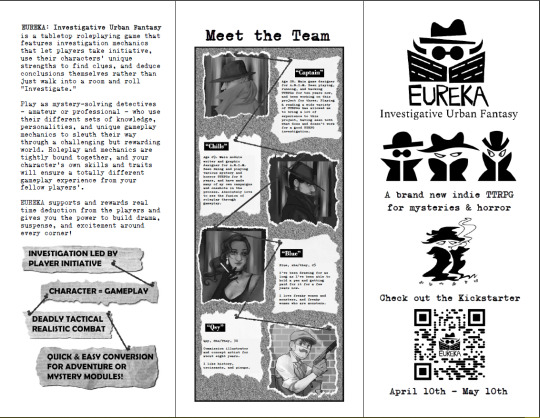

If you’re interested in a more updated and improved version of Eureka: Investigative Urban Fantasy than the free demo you got from our website, there’s plenty of ways to get one!
Subscribe to our Patreon where we frequently roll our new updates for the prerelease version!
Donate to our ko-fi and send us an email with proof that you did, and we’ll email you back with the full Eureka prerelease package with the most updated version at the time of responding! (The email address can be found if you scroll down to the bottom of our website.)
We also have merchanise.

#dnd#dnd5e#dnd 5e homebrew#dungeons and dragons#d&d#d&d 5e#dungeons and dragons 5e#dnd 5e#5e#homebrew#dungeons & dragons#critical role#crit role#dimension 20#actual play#matt mercer#wizards of the coast#wotc#hasbro#ttrpgs#ttrpg#ttrpg community#ttrpg tumblr#tabletop#roleplay#roleplaying#roleplaying games#tabletop roleplaying#tabletop role playing game#fantasy rpg
707 notes
·
View notes
Text
TTRPG Design For Evil
In my somehow unending quest to write the worst TTRPG, I have designed the following:
What Little The Flames Leave Us, a game where you light your character sheet on fire and put it out. Repeatedly. To pass basic checks.
Fear No Evil, where you throw a d4 into a room, turn the lights off, take your shoes off, and then stride fearlessly through.
Bottom Gun, where you can only take actions by texting emojis at the GM, who has to interpret them.
Sexyback, where there's one player and like an entire greek chorus of GMs who vote on the player's next actions.
And finally Hot In Here: A Game Of Antarctic Exploration, where you play as members of the Shackleton expedition and the mechanics consist of stripping, but there's also a counter mechanic where you can put clothes on other people.
#ttrpg#ttrpg homebrew#ttrpgs#ttrpg design#indie ttrpgs#indie ttrpg#rpg#tabletop#rpgs#cw theoretical nudity
1K notes
·
View notes
Text
Unpopular opinion.
Christianity is legitimately just a bunch of people disagreeing about how to play DND
Catholics prefer Old school First Edition.
Eastern Orthodox Christians Prefer 3.5
Protestants just are deadest on 5e
And all the cults that mascarade as “Christian” for cultural acceptance prefer Homebrew games.
#Religion#catholocism#protestantism#orthodoxy#DND#5e#Path Finder#dnd first edition#homebrew rpg#rp#roleplaying games#table top rpg
0 notes
Text

Yes, ANOTHER RPG character today, however, this will be an NPC for a game that i plan on dming for my friends. It's gonna be pirate themed! YIPPEE!!!
His name is Gill :>
#artists on tumblr#art#drawing#hand drawn#fish person#dnd character#homebrew#homebrew rpg#rpg#oc#pirates#pirate rpg
11 notes
·
View notes
Text

8K notes
·
View notes
Text
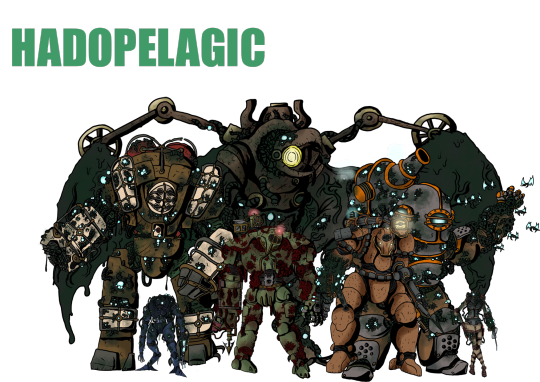
Introducing: What I've been working on for so long, the Hadopelagic lineup, a roster of corrupted, mech files with each instance of corruption manifesting as a strange cancerous growth across the mechs. These non-union designed machinies boast an array of tech and direct combat capabilites, as well as unique weapons with interesting features.
It is advised to keep COMP/CONs and Demios entity NHPs away from this technology. The specifics are still not understood, but this tech predates the earliest known HORUS cells.
Rules and .lcp data for these mechs should be coming out later this year. Until then I hope you're just as excited as we are for the fruits of this project.
#my art#my artwork#artists on tumblr#art#digital art#digital artwork#digital illustration#mecha#character design#lancer#lancer rpg#lancerrpg#lancer art#lancer homebrew#diver#Hadopelagic
273 notes
·
View notes
Photo
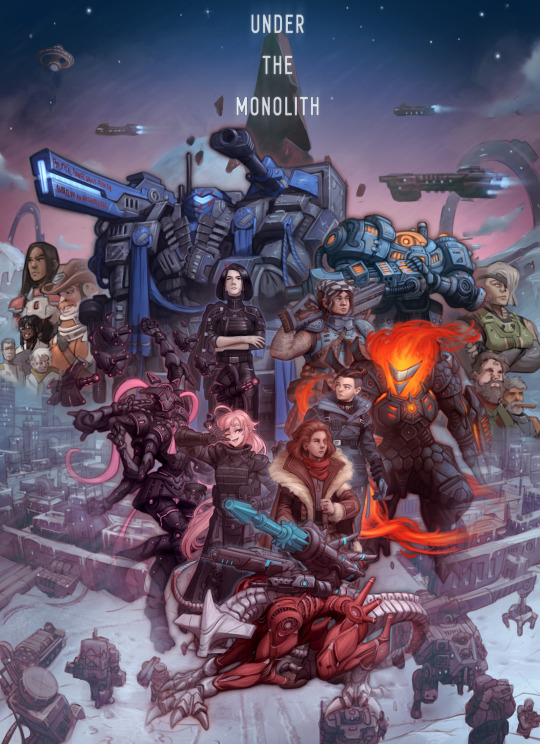
An illustration for another one of my groups Lancer campaigns, Under the Monolith
#lancer#lancerrpg#lancer rpg#ttrpg campaign#lancer ttrpg#ttrpg homebrew#ttrpgsolidarity#ttrpg art#ttrpg#purple#rpg art#ttrpg artist#illustration#illustrator#digital art#Digital Illustration#mech#mecha#mechas#mechs#robot#robots#horus#harrison armory#ips-n#ipsn#zheng#barbarossa#balor#hydra
2K notes
·
View notes
Text

Alison Cunningham
0 notes
Text
I’m releasing a TTRPG supplement

Kind of says it all, really.
Brought to life by the illustrations of the talented Kate Lucas (https://skeejeedoodles.carrd.co/), the supplement is on sale now at:
https://hyrune.itch.io/the-goblin-market
Hey folks. My name is David, I’m a queer games designer and writer from Ireland. In the autumn of last year, I was made redundant from my job of eleven years, and taking a look back over that time I realised I’d lost time. I’d lost so much creative spark that previously drove me, and in a fit of frenzied, caffeine-fuelled panic inspiration, I got to work making something.
I’ve been playing tabletop RPGs for many years, both as a GM and as a player. As a GM, I’ve occasionally struggled when players go off the beaten track - you haven’t lived until you’ve stared blankly around the table, trying to think of a name for a random NPC you didn’t anticipate at all, having your eyes land on a coffee cup and proudly declaring their name is “Uhhhh... Muggsley.”
If you’ve ever been in a position where your players are shopping, and you’ve had to quickly drum up a string of shopkeepers and vendors on-the-fly, this book might just help you. The Goblin Market is a system agnostic collection of over fifty merchants, monsters and even stranger things which can be dropped into your campaign to add weirdness and magic for your players: retired river gods, escaped nightmares, tea merchants, vengeful dragons seeking to raise an army to defeat tyrannical princesses, off-duty demons, magical roboticists, mystery cults, accidentally immortal witches, and more besides.
Each entry details a merchant and the items they both buy and sell, but also contains a number of plot hooks (over 140, last time I checked) so you can give your players sidequests to investigate. Each vendor can be dropped into your game on their own, but also exists in a setting of their own - a setting where each market stallholder invokes and involves other entries and merchants as rivals, romantic interests, family members and possible eldritch accomplices from the days before the Moon was born. It’s a living, breathing place, and I’ve loved writing it so, so much.
2K notes
·
View notes
Text
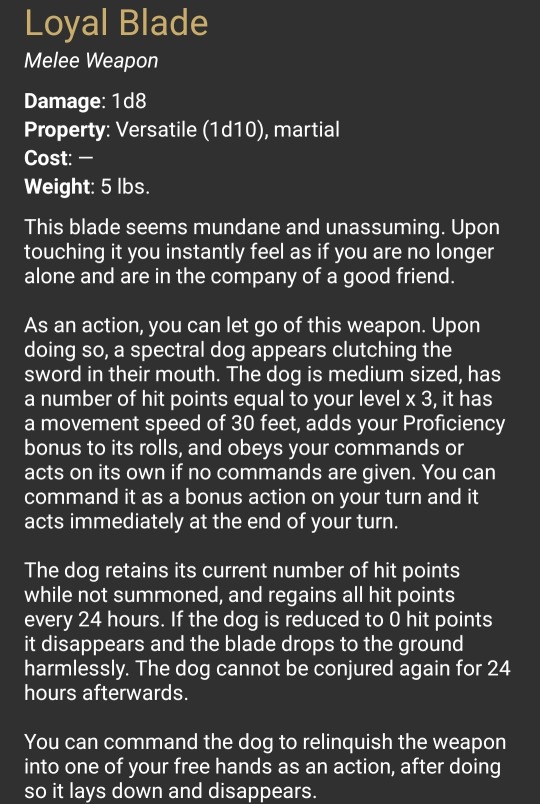
Howdy! Here's the goodest blade to have ever been forged! I had the idea for this item the other day and wanted to make it!
#dungeons and dragons#dnd#d&d#dungeons & dragons#5e#homebrew#rpg#good boy#magic item#dog#inspired by sif because all dogs wielding swords can trace their lineage back to them
2K notes
·
View notes